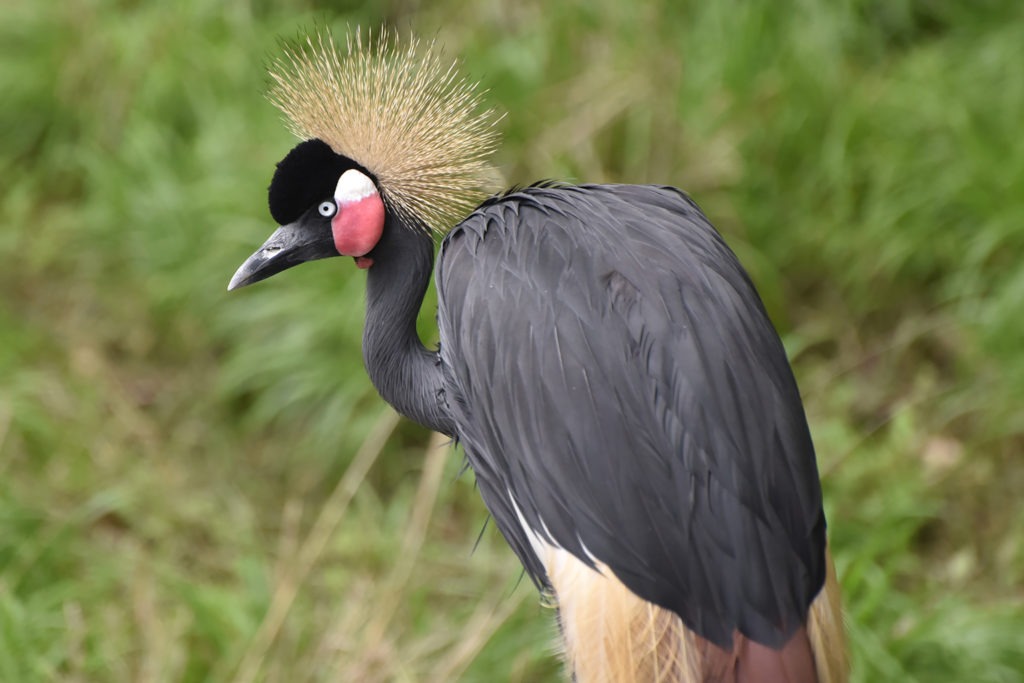Overview
“Where I live”
Black crowned cranes live in equatorial Africa, in wetland portions of grasslands and open savannahs, flooded lowlands, and wet croplands.
Visitors to The Maryland Zoo can see Black crowned cranes from the boardwalk in the African Journey exhibit.
“How I live there”
Black crowned cranes are monogamous birds that form pairs for life. Pairs can be seen together even in the middle of a large flock, which suggests an exceptionally strong pair bond. Adult cranes reinforce their pair bond by dancing for and with each other. They perform ritualistic dance displays that include bows, leaps, runs, wing flapping, short flights, jerky bouncing, running, and stick tossing. Cranes of all ages dance. Among younger birds, dancing may serve to reduce aggression with other cranes, provide physical exercise, and possibly relieve anxiety.
Black crowned cranes roost in trees at night and are active during the day. They spend 50-75% of their waking hours foraging for food. They may seek shade and rest during the hottest part of the day, and will pant visibly on extremely hot days. They feed on seed heads, grasses, and some cultivated crops as well as insects, mollusks, crustaceans, small fish, amphibians, and reptiles. They are known to stamp their feet when walking through grassy vegetation in order to stir up insects that they can feed upon. They will also walk among grazing cattle, presumably to catch insects that cattle disturb and/or attract. They tend to forage most in grasses growing near marshes and swamps, and in croplands.
“Making my mark”
Black crowned cranes are quite noticeable when gathering together and roosting in large flocks.
“What eats me”
Black crowned crane chicks have many natural predators, from wild cats and dogs to birds of prey. Only about 30% of chicks survive their first three months of life. Adults, on the other hand, are rarely taken by predators. Local farmers sometimes view them as pests because they tend to exploit croplands and can damage crops such as groundnuts and soybeans. They also can destroy cotton seedlings by walking on them.
Raising Young
Pairs cooperatively build nests, incubate eggs, and care for their young. Black crowned cranes nest in or very near standing water, in marshes, swamps, or flooded fields of rice, yams, or atcha. Females lay clutches of 3-4 eggs and incubation lasts about 30 days. Pairs will defend their nesting territory aggressively.
After the chicks hatch, they stay near the nest for about a day and then begin to follow their parents around in search of food. A family of black crowned cranes will stay together for 9-10 months before the parents drive the young away in preparation for nesting again. Once driven off by their parents, young cranes often flock together.
Downy chicks are pale buff and turn grayish as juveniles. They attain their adult plumage by about 12 months of age.
Conservation
Black crowned cranes are listed as vulnerable by the IUCN, the world’s leading conservation organization. The species is under pressure because of habitat loss and destruction, as well as over-collection for the pet trade. Much of the wetlands and grasslands of their native equatorial West Africa have been converted to pasture and agricultural land, and drought also has ravaged the land in recent decades.
Taxonomy
- Kingdom: Animalia
- Phylum: Chordata
- Subphylum: Vertebrata
- Class: Aves
- Order: Gruiformes
- Family: Gruidae
- Genera: Balearica
- Species: pavonina pavonina


